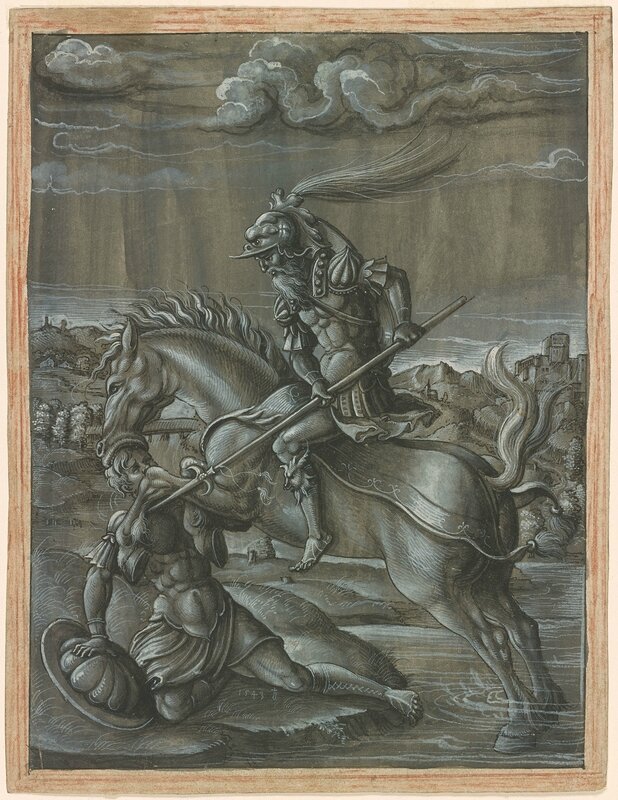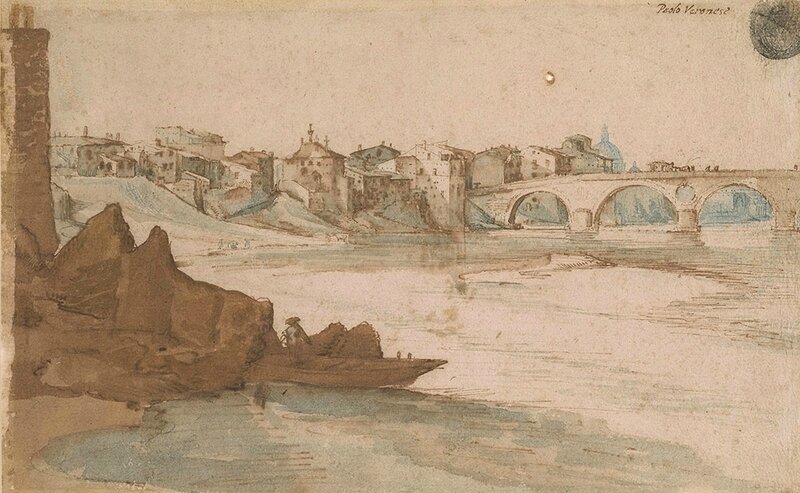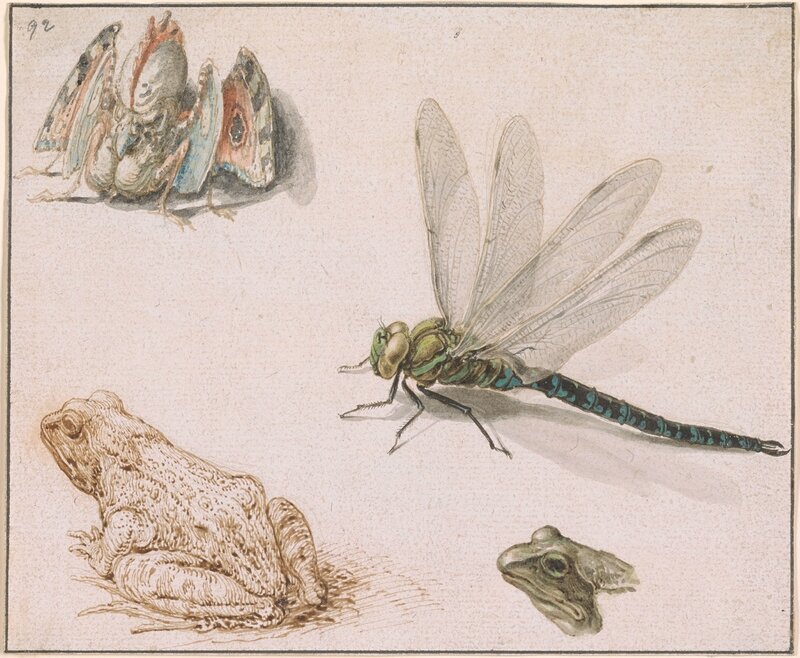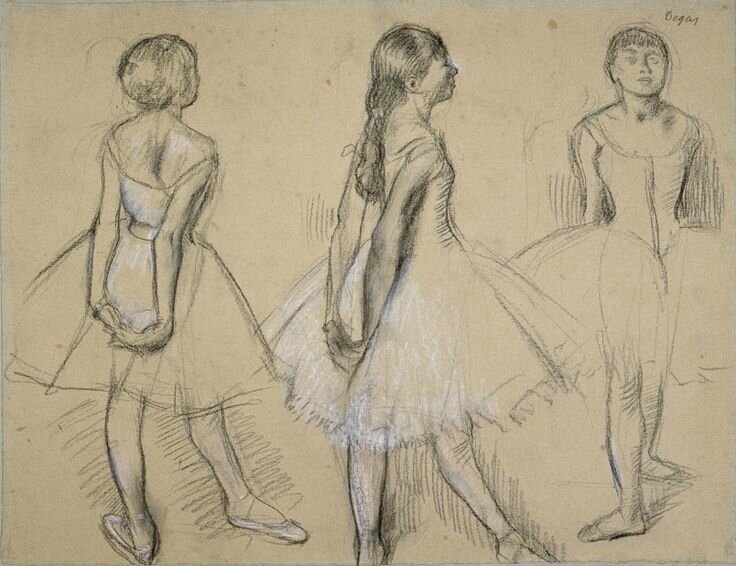Clark Art Institute presents noted drawings from the Eugene V. Thaw Collection
Jörg Breu the Younger (German, c. 1510-1547), Artybios on Horseback Attacking Onesilus, 1543. Pen and black ink and gray wash with white gouache on gray paper, 8 3/4 × 6 11/16 in. (22.2 × 17 cm). Gift in Honor of Charles Ryskamp on his 10th Anniversary as Director. Morgan Library & Museum, Thaw Collection, 1978.38.
WILLIAMSTOWN, MASS.- Over the past fifty years, New York art dealer and philanthropist Eugene V. Thaw assembled one of the world’s finest private collections of drawings. The collection, known for its breadth and exceptional quality, charts the high points of drawing from the Renaissance through the twentieth century and features works made by pivotal artists at key moments in the history of the art form. Mr. Thaw donated his collection of more than 400 drawings to the Morgan Library & Museum, New York, which celebrated the gift with the September 2017 opening of Drawn to Greatness: Master Drawings from the Thaw Collection, an exhibition that has drawn critical acclaim for the diversity and quality of the works presented. In recognition of Mr. Thaw’s longstanding interest in the Clark Art Institute, Drawn to Greatness traveled to Williamstown for an exclusive presentation at the Clark from February 3 through April 22, 2018. Featuring 150 drawings that tell the story of a visionary collector, the exhibition examines five centuries of western drawing. Sketchbooks belonging to Jackson Pollock, Francisco de Goya, Edgar Degas, and Paul Cézanne and illustrated letters from Vincent van Gogh are among the works exhibited.
“It is an honor for the Clark to have the opportunity to show this exquisite collection in our galleries,” said Olivier Meslay, the Felda and Dena Hardymon Director of the Clark. “The works in this exhibition provide an incredibly rich and remarkable opportunity to consider the art form as practiced by generations of masters. It is one of the most important and impressive drawing exhibitions that has been assembled in decades.”
The exhibition is organized in a series of chronological sections that illustrate key moments in the history of draftsmanship while also highlighting the work of artists whom the Thaws collected in depth, among them Rembrandt van Rijn, Francisco de Goya, Odilon Redon, and Edgar Degas.
“These exceptional drawings, watercolors, and collages exemplify both the eternal power of the drawn line and the innovative genius of the artists who have explored the medium over five centuries,” said Jay A Clarke, Manton Curator of Prints, Drawings, and Photographs. “It is a truly spectacular collection of works and I am thrilled to be able to work in collaboration with the Morgan’s curatorial team to bring this show to the Clark.”
The Rise of Drawing in the Renaissance
In the fifteenth and sixteenth centuries, drawing came to be understood not merely as a mechanic practice but as an intellectual one. With the growing availability of paper and bound sketchbooks, artists produced more personal and exploratory works on individual sheets of paper. This dramatic change was a central element in the development of Renaissance art. Andrea Mantegna (Italian, c. 1431–1506) most likely created Three Standing Saints (c. 1450–50) in preparation for a painting. This rare surviving drawing by one of the most important artists of the period depicts three versions of a single figure, most likely St. Andrew or St. Philip.
Andrea Mantegna (Italian, c. 1431–1506), Three Standing Saints, c. 1450–50. Pen and brown ink on paper, 7 × 7 1/2 in. (17.8 × 19.1 cm); frame: 17 1/2 × 17 1/2 × 1 9/16 in. (44.5 × 44.5 × 4 cm). Morgan Library & Museum, Thaw Collection, 1985.100.
During the Renaissance, there was an increase in drawings made as independent, finished works. Jan Bruegel (Flemish, 1568–1625) created A View of the Tiber in Rome with Ponte Sisto and St. Peter’s in the Distance (c. 1594) not in preparation for a final work, but to record his travels. Two Lovers by a Fountain in a Landscape (c. 1509–10) by Albrecht Altdorfer (German, c. 1480–1538) is an example of a finished work created in response to the emerging class of collectors and connoisseurs.
Jan Brueghel the Elder (Flemish, 1568–1625), A View of the Tiber in Rome with Ponte Sisto and St. Peter’s in the Distance, c. 1594. Pen and brown ink and wash and blue watercolor over black chalk on paper, 6 5/16 × 10 1/16 in. (16 × 25.6 cm); frame: 15 1/4 × 18 1/2 × 1 1/2 in. (38.7 × 47 × 3.8 cm). Morgan Library & Museum, Thaw Collection, 2017.20.
Albrecht Altdorfer (German, c. 1480–1538), Two Lovers by a Fountain in a Landscape, c. 1509–10. Pen and black ink and white gouache on brown prepared paper, 6 3/8 × 4 5/8 in. (16.2 × 11.7 cm); frame: 18 3/8 × 15 1/4 × 1 1/2 in. (46.7 × 38.7 × 3.8 cm). Morgan Library & Museum, Thaw Collection, 2006.51.
Looking at the World in the Seventeenth Century
Seventeenth-century artists continued the tradition of the intellectual approach to drawing that began in the Renaissance. Artists, particularly those in the northern Europe, looked for inspiration in the world around them, studying subjects from life and focusing their work on landscapes, still lifes, genre scenes, and portraits.
Rembrandt van Rijn (Dutch, 1606–1669) was a tireless draftsman and chronicler of the world around him, recording scenes of everyday life from the streets of Amsterdam to the nearby countryside. His powers of observation were so keen that the locations of his landscapes remain identifiable to scholars 300 years after they were drawn. The Bulwark De Rose and the Windmill De Smeerpot, Amsterdam (ca. 1649–52) demonstrates the artist’s ability to render a scene with great accuracy and an economy of line. In Four Musicians with Wind Instruments (c. 1638) Rembrandt adds a note of humor to a scene portraying street musicians by depicting the flutist with his cheeks inflated.
Rembrandt van Rijn (Dutch, 1606–1669), The Bulwark De Rose and the Windmill De Smeerpot, Amsterdam, c. 1649–52. Pen and brown ink and wash on paper, 5 1/4 × 8 9/16 in. (13.3 × 21.7 cm); frame: 15 × 19 1/4 × 1 1/8 in. (38.1 × 48.9 × 2.9 cm). Morgan Library & Museum, Thaw Collection, 2006.47.
Rembrandt van Rijn (Dutch, 1606–1669), Four Musicians with vind instruments, c. 1638. Pen and brown and black ink and brown wash, and red and yellow chalk on paper, 7 1/16 × 5 1/4 in. (17.9 × 13.3 cm); frame: 15 1/8 × 12 5/8 × 1 1/4 in. (38.4 × 32.1 × 3.2 cm). Morgan Library & Museum, Thaw Collection, 2004.42.
In this period, artists also looked closely at the natural world. Jacques de Gheyn II’s (Dutch, 1565–1629) Studies of a Fantastic Bird, Toad, Frog, and Dragonfly (c. 1596–1602) combines accurately rendered depictions of a toad, frog, and dragonfly joined by a bird-like creature of pure fantasy.
Jacques de Gheyn II (Dutch, 1565–1629), Studies of a Fantastic Bird, Toad, Frog, and Dragonfly, c. 1596–1602. Pen and brown ink, watercolor, and gouache on paper, 4 1/2 × 5 1/2 in. (11.4 × 14 cm); frame: 10 1/4 × 11 5/8 × 1 in. (26 × 29.5 × 2.5 cm). Morgan Library & Museum, Thaw Collection, 2004.40.
Contemporary Life and Fantasy in Eighteenth-century Italy
Connoisseurship continued to grow in the eighteenth century, increasing the demand for independent drawings. Drawings were executed primarily in pen and ink washes on new varieties of bright white paper in ever-greater numbers. These luminous drawings featured subjects that combined elements of fantasy and reality, often infused with a sense of comedy.
Artists represented views of their cities with pride along with scenes from the imagination known as “capricci.” Giovanni Antonio Canal’s (Italian, 1697–1768) Capriccio: Pavilion by the Lagoon (c. 1760) is a highly finished drawing typical of the artist’s late work. It is executed in brown ink in combination with gray wash, allowing the white of the paper to convey the sense of sunlight playing off the masonry.
Giovanni Antonio Canal, called Canaletto (Italian, 1697–1768), Capriccio: Pavilion by the Lagoon, c. 1760. Pen and brown ink and gray wash on paper, 14 7/8 × 9 7/16 in. (37.8 × 24 cm); frame: 22 3/4 × 17 3/4 × 1 in. (57.8 × 45.1 × 2.5 cm). Morgan Library & Museum, Thaw Collection, 2005.235.
Toward the end of his career, Giovanni Domenico Tiepolo (Italian, 1727–1804) created a series of drawings known as Scenes of Contemporary Life, usually executed with a satirical or caricatured twist. The Picture Show (c. 1791) presents an itinerant storyteller enthusiastically describing, with pointer in hand, a picture on the wall before him to a crowd of onlookers.
Giovanni Domenico Tiepolo (Italian, 1727–1804), Scene of Contemporary Life: The Picture Show, 1791. Pen and brown and black ink and wash over black chalk on paper, 11 5/16 × 16 5/16 in. Thaw Collection, Morgan Library & Museum, 2017.253.
Artists Drawing Everywhere: Rococo and Enlightenment in France
While drawing was firmly established as part of studio practice in Paris and Rome, it was also an important tool for artists such as Jean-Antoine Watteau (French, 1684–1721) who worked mostly outside of the Academy. Watteau produced a vast array of life studies, such as Study of a Young Man Seen from the Back and a Study of a Right Arm (c. 1717), which he kept in albums for future use.
Jean-Antoine Watteau (French, 1684–1721), Study of a Young Man Seen from the Back and a Study of a Right Arm, c. 1717. Black, red, and white chalk, on paper, 8 3/16 × 9 in. (20.8 × 22.9 cm); frame: 16 3/4 × 17 5/8 × 1 1/2 in. (42.5 × 44.8 × 3.8 cm). Morgan Library & Museum, Thaw Collection, 2000.56.
The growing interest in foreign customs is in Jean-Baptiste Greuze’s (French, 1725–1805) The Game of Morra (1756). In the Italian game, still being played today, raucous competitors display a certain number of fingers from their right hands while loudly guessing the total number of fingers presented by both players. The dilapidated courtyard setting and dismayed faces of the players suggests Greuze did not approve of the activity.
Jean-Baptiste Greuze (French, 1725–1805), The Game of Morra, 1756. Pen and brown ink and wash with gray wash over graphite on paper, 9 3/4 × 14 1/4 in. (24.8 × 36.2 cm); frame: 18 7/8 × 23 1/8 × 1 1/4 in. (47.9 × 58.7 × 3.2 cm). Morgan Library & Museum, Thaw Collection, 2017.109.
Revolution and Romanticism
In the late eighteenth and early nineteenth centuries, drawing in England and Germany became a forum for social issues and subjective explorations. The formation of drawing societies encouraged the production, exhibition, and collecting of drawings. Artists embraced watercolor as a medium and investigated subjects related to literature, philosophy history and religion. Examinations of spirituality by Caspar David Friedrich (German, 1774–1840) and William Blake (English, 1757–1827) match the sublime landscapes of J.M.W. Turner (English, 1775 1851) and Samuel Palmer (English, 1805–1881).
Caspar David Friedrich (German, 1774–1840), Moonlit Landscape. Before 1808. Watercolor and gouache on paper; with, cut- and- pasted insert, 9 1/8 × 14 3/8 in. (23.2 × 36.5 cm); secondary support: 9 1/2 × 14 5/8 in. (24.1 × 37.1 cm); frame: 17 13/16 × 23 3/16 × 2 1/4 in. (45.2 × 58.9 × 5.7 cm). Morgan Library & Museum, Thaw Collection, 1996.150.
Samuel Palmer (English, 1805–1881), Pear Tree in a Walled Garden, c. 1829. Watercolor and gouache, over graphite, on paper, 8 3/4 × 11 1/8 in. (22.2 × 28.3 cm); frame: 16 5/8 × 20 1/8 × 1 1/2 in. (42.2 × 51.1 × 3.8 cm). Morgan Library & Museum, Thaw Collection, 1980.37.
Francisco de Goya (Spanish, 1746–1828) kept sketchbooks in which he drew his private ideas. The subject matter varies from critiquing social mores and poking fun at personal idiosyncrasies to scenes from the artist’s imagination. Some of these compositions reappeared in later print series and paintings while others remained in albums discovered after Goya’s death.
Francisco de Goya (Spanish, 1746–1828), Leave It All to Providence, From the Black Border Album, 1816–20. Black ink and gray wash on paper, 10 1/2 × 7 1/4 in. (26.7 × 18.4 cm); frame: 20 3/8 × 17 × 1 1/2 in. (51.8 × 43.2 × 3.8 cm). Morgan Library & Museum, Thaw Collection, 1999.22.
Eugène Delacroix (French, 1798–1863) produced scenes he would revisit and revise over the years. His celebrated watercolor Royal Tiger (c. 1830) depicts the animal resting in a rocky landscape. It is a variation of a lithograph produced in 1829–30 following a visit to the Jardin des Plantes.
Eugène Delacroix (French, 1798-1863), Royal Tiger, c. 1830. Watercolor and graphite on paper, 7 × 10 1/2 in. Thaw Collection, Morgan Library & Museum, 206.54.
From the Everyday to the Sublime: Drawing in France after the Revolution
By the middle of the nineteenth century, many artists worked closely with dealers to produce a remarkable variety of finished drawings for sale at art markets and galleries in Paris. Artists were politically engaged, and their frank assessment of modern life at a time of increasing urbanization yielded new subject matter—including scenes infused with pathos for the working class such as Jean-François Millet’s (French, 1814–1875) The Potato Harvest (c. 1853) and humor as in Honoré Daumier’s (French, 1808–1879) Two Lawyers Conversing (c. 1862).
Jean-François Millet (French, 1814–1875), The Potato Harvest, c. 1853.Black and white chalk on paper, 9 × 13 3/4 in. (22.9 × 34.9 cm); frame: 20 1/4 × 25 × 1 3/8 in. (51.4 × 63.5 × 3.5 cm). Morgan Library & Museum, Thaw Collection, 2010.114.
Honoré Daumier (French, 1808–1879), Two Lawyers Conversing, c. 1862. Black chalk, lithographic crayon, watercolor and gouache with graphite on paper. Morgan Library & Museum, Thaw Collection, 1997.87.
Odilon Redon (French, 1840–1916) experimented with materials and developed an unconventional visual language that rejected realism and embraced dark imagery and emotions. In the late 1870s Redon began an extremely productive creative period in which he worked almost exclusively in black chalks. Large sheets such as The Sphinx (1883) and The Spider (1902), referred to as noirs, drew on a broad range of symbolic sources and references.
Odilon Redon (French, 1840–1916), The Spider, 1902. Charcoal and black pastel with smudging and erasing on paper, 19 11/16 × 13 3/4 in. (50 × 34.9 cm). Morgan Library & Museum, Thaw Collection, 2017.208.
Charting New Territory: Impressionist and Post-Impressionist Drawings
Despite the belief that painting directly on canvas rendered drawing unnecessary, drawing continued to play a vital role in the artistic process among avant-garde artists in France during the late nineteenth century. Artists continued to work from life and nature, recording observations and studying figures and the landscape. They also used drawing to replicate compositions, rework ideas, and produce finished works for exhibition and sale.
Artists utilized diverse media including manufactured materials such as the Conté crayon used by Georges Seurat (French, 1859–1891) in The Black Horse (1882) and Approach to the Bridge at Courbevoie (1886). Paul Cézanne (French, 1839–1906) pushed the boundaries of watercolor in his prismatic Trees (c. 1900–1906), while Edgar Degas (French, 1834–1917) expanded the definition of drawing by applying thinned oil paint and pastel over prints, such as Landscape with Path Leading to a Copse of Trees (ca. 1890–92).
Georges Seurat (French, 1859–1891), The Black Horse, 1882. Black Conté crayon on paper. Morgan Library & Museum, Thaw Collection, 2011.29.
Paul Cézanne (French, 1839–1906), Trees, c. 1900–6. Watercolor over graphite on paper, 18 × 11 3/4 in. (45.7 × 29.8 cm); frame: 28 3/8 × 21 3/8 × 2 1/8 in. (72.1 × 54.3 × 5.4 cm). Given in honor of S. Parker Gilbert. Morgan Library & Museum, Thaw Collection, 2015.93.
Vincent van Gogh (Dutch, 1853–1890) used drawings in his letters sent from Arles to friends in Paris. The letters contained sketches of paintings in progress and descriptions of work and French countryside. Drawn to Greatness features two illustrated letters from the artist to his friend Émile Bernard: one with sketches of a sower and wheat field, the other depicting the Langlois Bridge at Arles.
Modern Forms
Twentieth-century artists continued to depict traditional subjects in conventional materials, as is evident in Pablo Picasso’s (Spanish, 1881–1973) portraits, Henri Matisse’s (French, 1869–1954) still lifes, and Piet Mondrian’s (Dutch, 1872–1944) landscapes. These artists also generated new forms as a response to modern life and reflected new ways of seeing and thinking about space, time, and movement. Cubism perhaps best demonstrates this new approach seen in Pipe and Wineglass by Picasso, in Man with Opera Hat (1912) by Juan Gris (Spanish, 1887–1927), and in Composition (1918) by Fernand Léger (French, 1881–1955).
Juan Gris (Spanish, 1887–1927), Man with Opera Hat, 1912. Black fabricated chalk on paper, 18 3/4 × 12 1/2 in. (47.6 × 31.8 cm); frame: 30 3/8 × 24 1/8 × 1 3/4 in. (77.2 × 61.3 × 4.4 cm). Morgan Library & Museum, Thaw Collection, 2017.111.
The advent of abstraction as well as explorations of the subconscious and the irrational led to highly individual, distinctive works such as Jackson Pollock’s (American, 1912–1956) Untitled (Abstract Ram) (c. 1944). The diversity of his influences—from Native American art and Mexican mural painting to Picasso and Surrealism—indicates how much drawing has evolved throughout the course of Western art.
Jackson Pollock (American, 1912–1956), Untitled (Abstract Ram), c. 1944. Opaque paint, pen and black and red ink on paper, 29 3/4 x 19 3/4 inches (75.5 x 50.1 cm). Morgan Library & Museum, Thaw Collection, 2010.143.
The exhibition extends the Institute’s relationship to Mr. Thaw who, in 2016, made a generous gift to create the Eugene V. Thaw Gallery for Works on Paper in the Clark’s Manton Research Center.
Drawn to Greatness: Master Drawings from the Thaw Collection is organized by the Morgan Library & Museum, New York. The curator of the exhibition at the Morgan is Jennifer Tonkovich, Eugene and Clare Thaw Curator of Drawings and Prints; the curator at the Clark is Jay A. Clarke, Manton Curator of Prints, Drawings, and Photographs.
Vittore Carpaccio (Italian, 1460/66–1525/26), Virgin and Child with Saints in a Landscape, c. 1500–10. Pen and brown ink and wash over red and black chalk on paper, 7 1/2 × 9 5/16 in. (19 × 23.7 cm); frame: 17 1/8 × 19 1/8 × 1 7/8 in. (43.5 × 48.6 × 4.8 cm). Morgan Library & Museum, Thaw Collection, 2006.46.
Peter Paul Rubens (Flemish, 1577–1640), Descent from the Cross, c. 1617–18. Pen and brown ink and wash over black chalk on paper, 13 9/16 × 9 1/16 in. (34.4 × 23 cm); frame: 25 3/4 × 20 3/4 × 2 1/2 in. (65.4 × 52.7 × 6.4 cm). Morgan Library & Museum, Thaw Collection, 1998.26
Antoine Watteau (French, 1684–1721), A Member of the Persian Embassy, 1715. Red and black chalk on paper, 12 3/16 × 6 5/8 in. (30.9 × 16.8 cm); frame: 21 7/8 × 16 1/8 × 2 in. (55.6 × 41 × 5.1 cm). Morgan Library & Museum, Thaw Collection, 2000.54
Antoine Watteau (French, 1684–1721), Young Woman Wearing a Chemise, c. 1718. Black, red, and white chalk on paper, 6 7/8 × 8 1/8 in. (17.5 × 20.6 cm); frame: 16 1/4 × 17 1/2 × 2 in. (41.3 × 44.5 × 5.1 cm). Morgan Library & Museum, Thaw Collection, 2000.53.
Jean-Honoré Fragonard (French, 1732–1806), Portrait of a Neapolitan Woman, 1774. Brown wash over black chalk on paper, 14 7/16 × 11 1/8 in. (36.7 × 28.3 cm); frame: 26 1/2 × 23 1/8 × 2 1/4 in. (67.3 × 58.7 × 5.7 cm). Morgan Library & Museum, Thaw Collection, 2001.60.
Francesco Guardi (Italian, 1712–1793), Ascent of a Balloon in Venice, 1782–84. Pen and brown ink and wash over black chalk on paper, 9 7/16 × 9 13/16 in. (24 × 24.9 cm); frame: 24 × 21 1/2 × 1 3/8 in. (61 × 54.6 × 3.5 cm). Morgan Library & Museum, Thaw Collection, 2017.117.
Giovanni Domenico Tiepolo (Italian, 1727–1804), The Last Illness of Punchinello, c. 1797–1804. Pen and brown ink and wash over black chalk on paper, 13 13/16 × 18 5/16 in. (35.1 × 46.5 cm); frame: 21 1/4 × 25 × 2 in. (54 × 63.5 × 5.1 cm). Morgan Library & Museum, Thaw Collection, 2017.258
Eugène Delacroix (French, 1798-1863), Moroccans Outside the Walls of Tangier, c. 1834. Watercolor and white gouache over graphite on paper, 7 3/8 × 10 5/16 in. (18.7 × 26.2 cm); frame: 13 3/8 × 18 1/2 × 2 5/8 in. (34 × 47 × 6.7 cm). Morgan Library & Museum, Thaw Collection, 2017.65.
Hilaire-Germain-Edgar Degas (French, 1834–1917), Seated Dancer, 1871–72. Oil over graphite on pink paper, 10 15/16 × 8 11/16 in. (27.8 × 22.1 cm); frame: 19 × 16 3/4 × 2 1/4 in. (48.3 × 42.5 × 5.7 cm). Morgan Library & Museum, Thaw Collection, 2017.54
Hilaire-Germain-Edgar Degas (French, 1834–1917), Three Studies of a Dancer, c. 1880. Black, pink, and white pastel on light brown paper, 18 3/4 × 24 3/4 in. (47.6 × 62.9 cm); frame: 29 7/8 × 35 1/2 × 1 7/8 in. (75.9 × 90.2 × 4.8 cm). Morgan Library & Museum, Thaw Collection, 2001.12.
Paul Cézanne (French, 1839–1906), The Bathers, c. 1900. Watercolor over graphite on paper, 7 15/16 × 10 13/16 in. (20.1 × 27.4 cm); frame: 14 × 17 1/4 × 1 1/2 in. (35.6 × 43.8 × 3.8 cm). Morgan Library & Museum, Thaw Collection, 2017.29.
Paul Gauguin (French, 1848–1903), Crouching Tahitian Woman Seen from the Back, c. 1902. Monotype in watercolor with white gouache on paper, 21 5/8 × 12 1/8 in. (54.9 × 30.8 cm); frame: 28 3/4 × 20 1/4 × 3 1/4 in. (73 × 51.4 × 8.3 cm). Morgan Library & Museum, Thaw Collection, 2017.90.
Jackson Pollock (American, 1912–1956), Untitled (Drawing for P. G.), c. 1943. Pen and black ink and wash, green ink wash, red colored pencil, and orange watercolor pencil on paper, 18 7/8 × 24 3/4 in. (47.9 × 62.9 cm); frame: 24 3/8 × 30 3/8 × 1 1/2 in. (61.9 × 77.2 × 3.8 cm). Morgan Library & Museum, Thaw Collection, 2006.59.

/https%3A%2F%2Fprofilepics.canalblog.com%2Fprofilepics%2F1%2F0%2F100183.jpg)
/https%3A%2F%2Fstorage.canalblog.com%2F03%2F02%2F119589%2F96711876_o.jpg)
/https%3A%2F%2Fstorage.canalblog.com%2F11%2F31%2F119589%2F94773502_o.jpg)
/https%3A%2F%2Fstorage.canalblog.com%2F20%2F83%2F119589%2F94772815_o.jpg)
/https%3A%2F%2Fstorage.canalblog.com%2F26%2F72%2F119589%2F75604929_o.jpg)
/https%3A%2F%2Fstorage.canalblog.com%2F59%2F60%2F119589%2F26458628_o.jpg)





































/http%3A%2F%2Fstorage.canalblog.com%2F19%2F23%2F119589%2F128179837_o.jpg)
/http%3A%2F%2Fstorage.canalblog.com%2F62%2F29%2F119589%2F126411628_o.jpg)
/http%3A%2F%2Fstorage.canalblog.com%2F15%2F87%2F119589%2F122308659_o.jpg)
/http%3A%2F%2Fstorage.canalblog.com%2F34%2F13%2F119589%2F120701661_o.jpg)